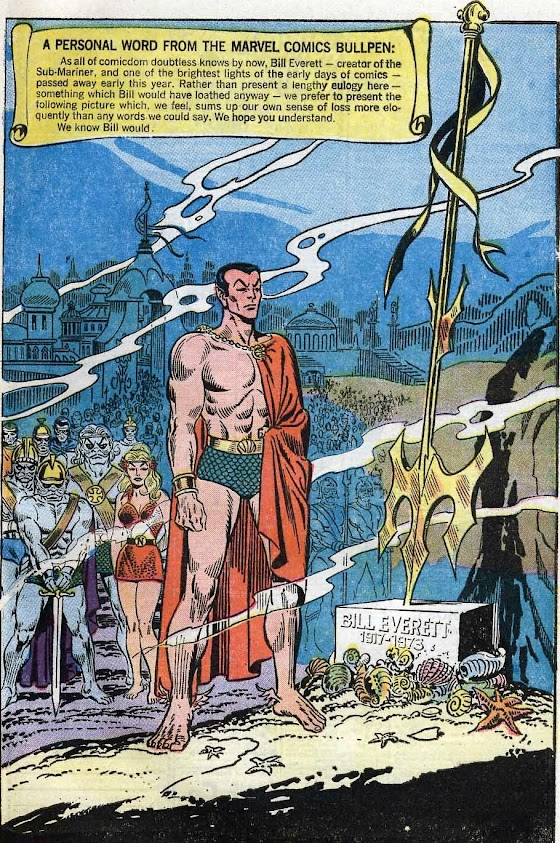I'd heard many of my friends raving about "Wakanda Forever" (to shorten its
name). They told me how good it is. This gave me high hopes when I
visited the cinema in Birmingham today. I was disappointed. It comes nowhere
near the quality of
the first Black Panther film. I would have given it an even lower rating if it hadn't improved in the
final half hour. The bright colours of the first film have been replaced by
mostly drab, murky cinematography. The story isn't exciting. The plot just
plods along.
I was particularly disappointed by the portrayal of Prince Namor, shown above
at Bill Everett's grave. The character called Namor in the film isn't the same
character as the one in the Marvel comics. Not even close. Namor in the film
is the ruler of Talokan, a sunken city based on the Aztec myths of Tlalocan.
This makes him ethnically central American, and he's played by a Mexican
actor. Namor in the comics is the ruler of the sunken city of Atlantis, and he
has a western European complexion.
The location of Atlantis is deliberately kept vague in Namor's early comic
appearances, but it's obviously somewhere in the North Atlantic Ocean between
America and Europe, probably closer to Europe. In later comics (Tales To
Astonish #96, October 1967) we find that the original Atlantis was in the
Antarctic, but after its destruction the Atlanteans relocated to the North
Atlantic.
Prince Namor, usually called the Sub-Mariner, first appeared in Marvel Mystery
Comics #1 in October 1939, written and drawn by Bill Everett. At first he
threatens to destroy the USA, but after falling in love with an American
policewoman he's persuaded that his real enemy is Nazi Germany. For the next
six years he battles the Nazis. After that his main enemy is Communists. He
wasn't an American, but he became a symbol of American patriotism.
After two years of appearing as a B-Story in Marvel Mystery Comics (the main
character was the Human Torch), Namor was given his own comic in March 1941.
It was cancelled after 42 issues in October 1955. Namor's adventures continued
in parallel in the first 91 issues of Marvel Mystery Comics.
All this time, Namor's stories were written and drawn by Bill Everett. This
changed in May 1962. Bill Everett's stories were written for Timely and Atlas
Comics. The rights to his stories and characters were acquired by Marvel
Comics in 1961. After a seven-year absence Namor was re-introduced in
Fantastic Four #4, written by Stan Lee.
After appearing in various comics as a villain, Namor was finally given his own story in Tales To Astonish #70 (August 1965).
This was a comic that he shared with the Hulk, who was relegated to the B-Story. At that time Namor was the more popular character with the fans.
Bill Everett returned as the artist in Tales To Astonish #78 (April 1966),
after which he drew most of the issues. Stan Lee continued to write most of
the stories. In my opinion, these 10-page stories were some of the best comics
ever written. But then again, I love everything Stan Lee ever wrote.
In May 1968 Namor was finally given his own full-length comic book. The
series was hit or miss. Roy Thomas wrote excellent stories for the first 40 issues.
After this he was followed by other writers of lesser quality. The series was
salvaged when Bill Everett took over the writing in Sub-Mariner #50 (June
1972), but his health was already failing and he couldn't write or draw on a
regular basis. After Bill Everett's death the series fell apart, and it was
finally cancelled after 72 issues.
That concludes my brief history of Prince Namor the Sub-Mariner in comics.
That's where you'll find the real Namor. The character in the film is a sham.







No comments:
Post a Comment
Tick the box "Notify me" to receive notification of replies.